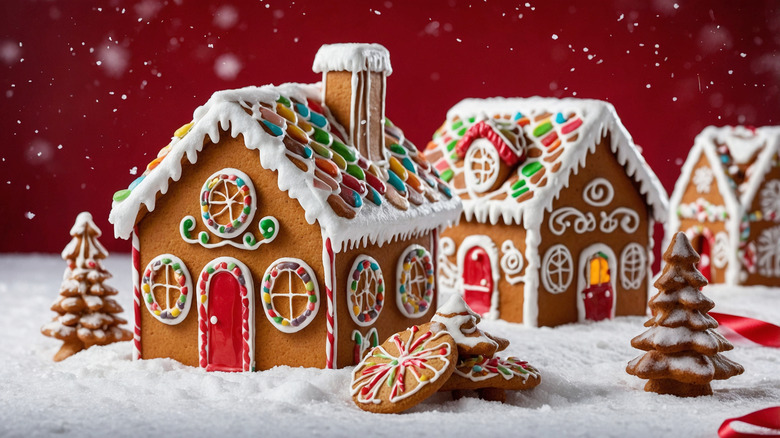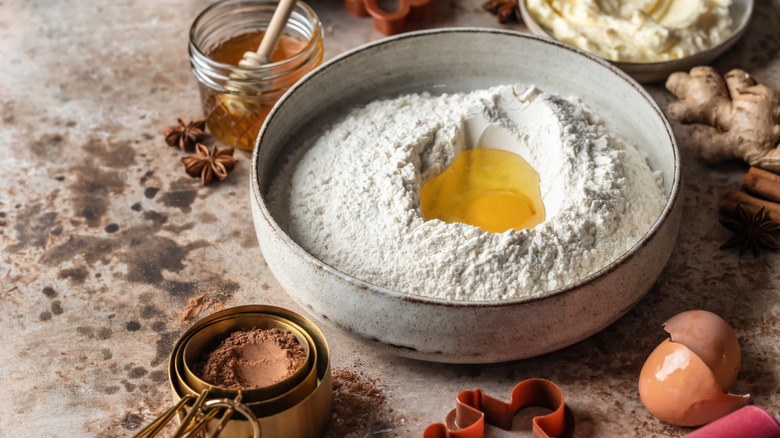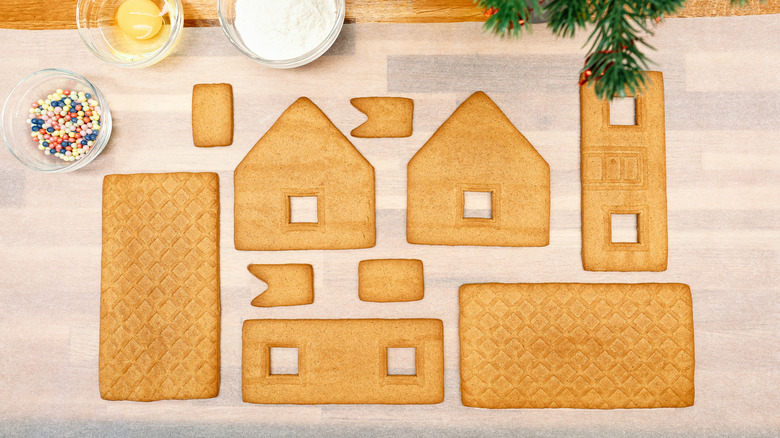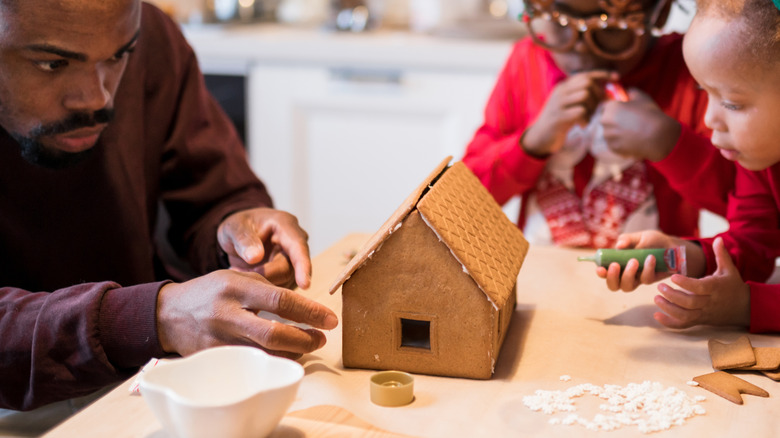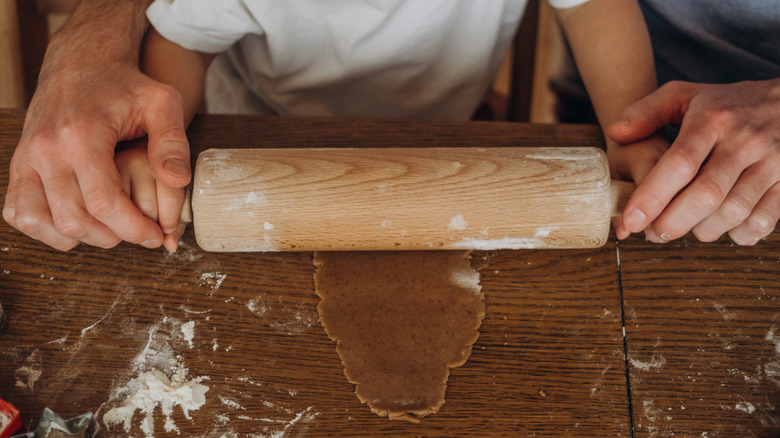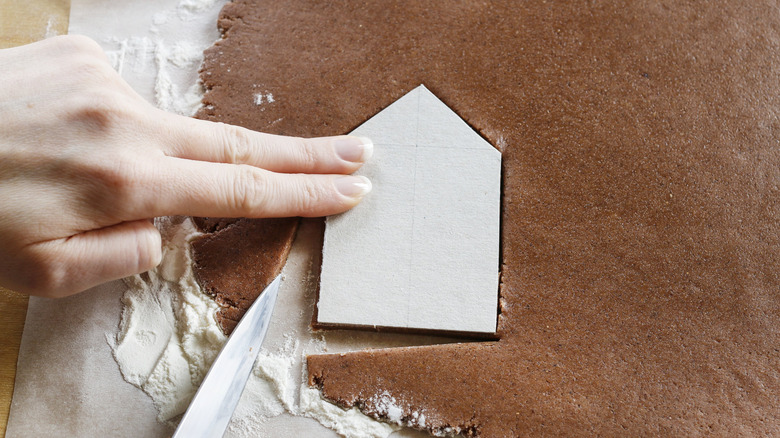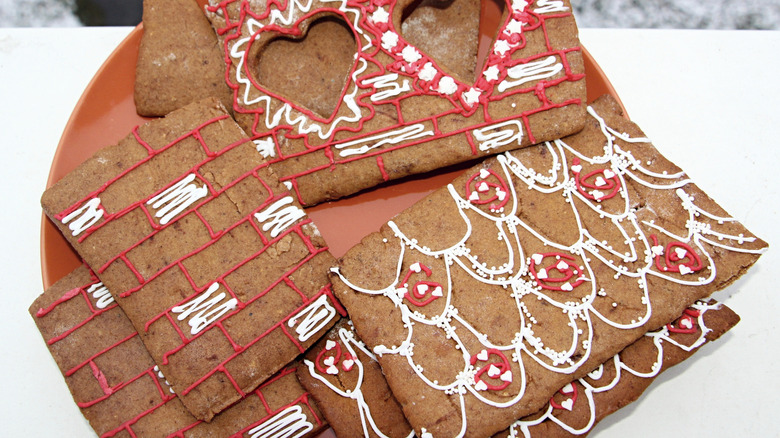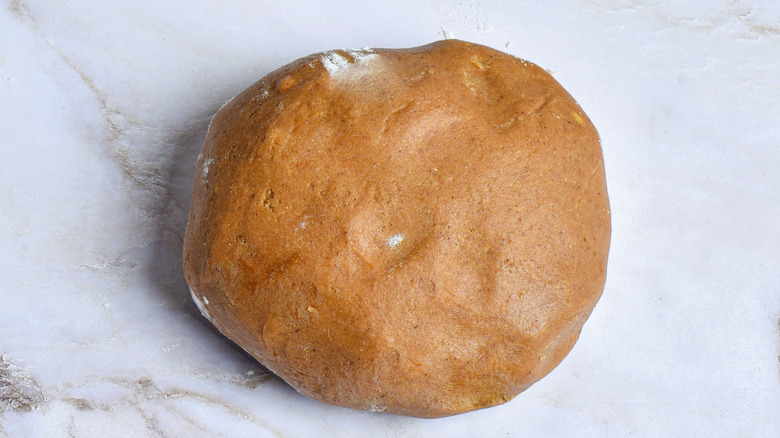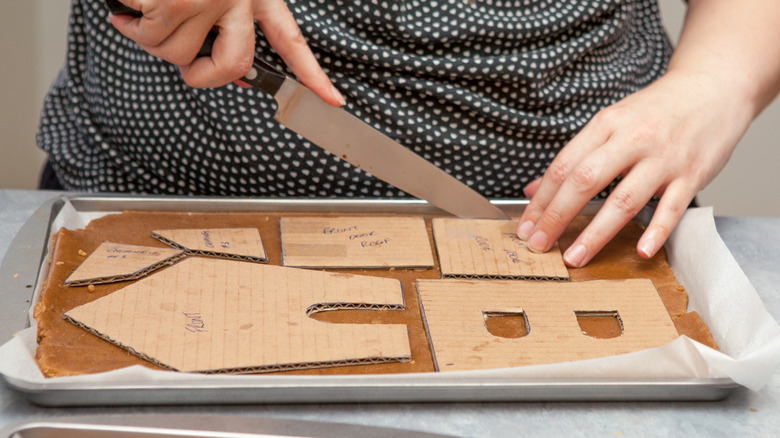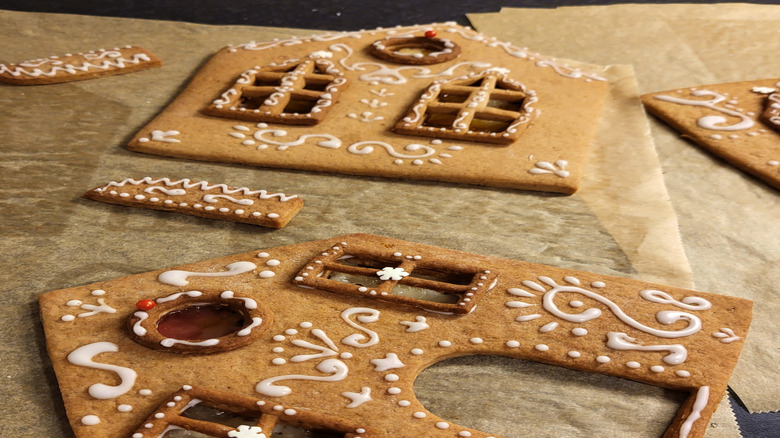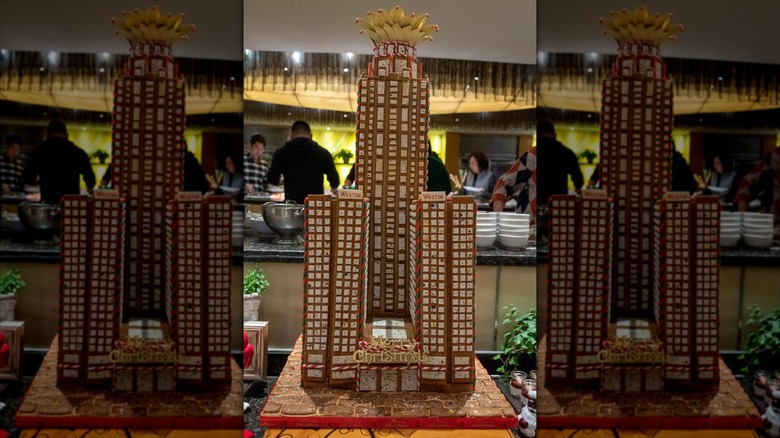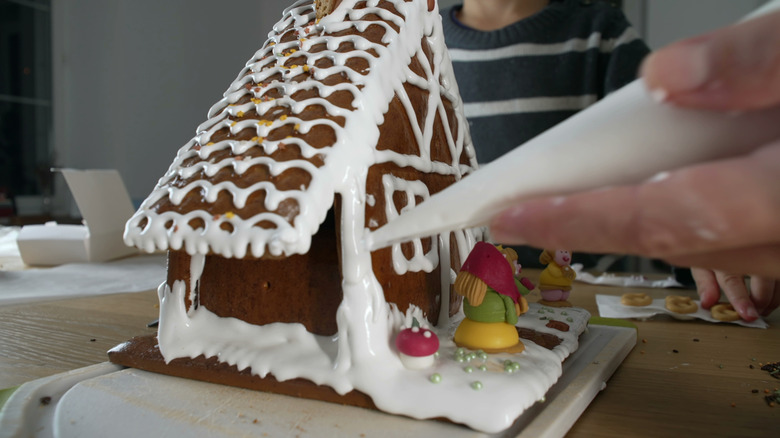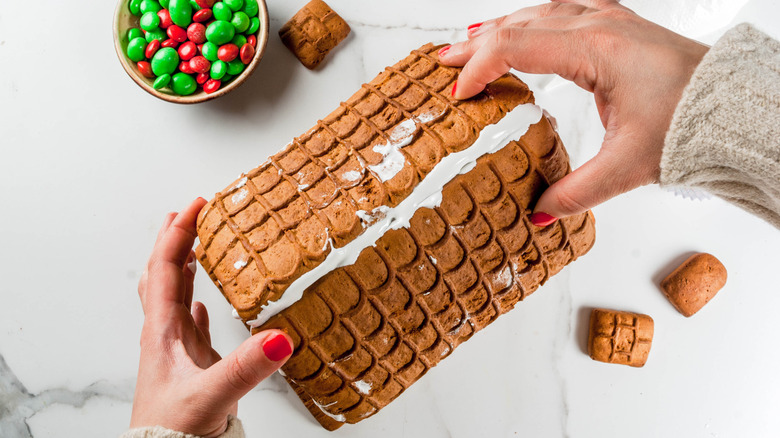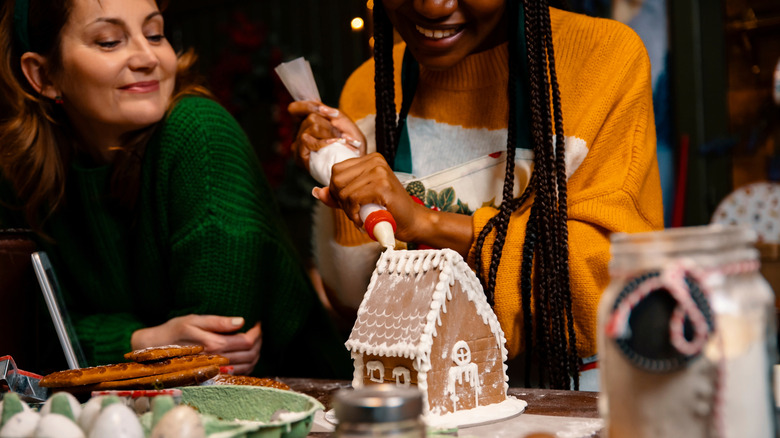13 Mistakes Everyone Makes With Gingerbread Houses, According To Experts
A gingerbread house is the perfect holiday-season centerpiece. Who wouldn't want to give a cute cottage made of cookies pride of place amid a spread of Christmas desserts? And it seems like they'd be fun to make with your loved ones — until you actually try it and end up bickering over collapsed walls and runny royal icing. It's not an easy feat to pull off and there are all kinds of common mistakes people make with gingerbread houses.
We know how tricky it is to pull off the perfect gingerbread house, so we spoke to three experts to get the lowdown. We have Julie McAllister of Julie McAllister Cakes, a professional gingerbread house maker and baker of hyper-realistic cakes. We also spoke to Katherine Sprung, a pastry chef and founder of Squish Marshmallows who has taught a virtual gingerbread house making class. Last but not least is Kelly Jacques, co-owner and chef of Ayu Bakehouse in New Orleans, who hosts gingerbread-house baking workshops.
This trio of experts has all the information you could need to make the perfect gingerbread house. They've told us where people usually go wrong and how to fix or avoid these issues.
1. Adding too much or too little spice to the recipe
Gingerbread is one of those foods that's easy to add too much or too little spice to. The clue is in the name — it's called gingerbread for a reason. It's meant to be fairly heavy on ginger, with other festive spices to back it up. However, you can go too far with it, so you need to know how to create balance.
"Most gingerbread cookie recipes have a spice combination of cinnamon, ginger, cloves, and nutmeg," Julie McAllister explains. She recommends following your recipe exactly to make sure the balance is just right. Katherine Sprung also suggests following a good recipe. It will have been tested carefully and should have the proper level of spice. "While you don't want to go overboard on the spices, you definitely don't want to skimp," she remarks, adding that those warm spices are what makes the cookie.
You might also want to adjust according to your preferences. Maybe you like a lot of spice. I, for one, am a cinnamon fiend and usually use twice as much as any recipe calls for. In this case, you can taste as you go, which is what Kelly Jacques advises. If you're trying to make changes to a recipe that you want to replicate, she suggests using a gram scale to be totally precise.
2. Choosing flavor and texture over stability
Yes, you want your gingerbread house to taste decent if you plan on tucking into it. But, honestly, these bakes are more about looks than taste or texture. One mistake people often make is prioritizing the quality of the cookie in terms of eating over its stability.
Julie McAllister, who makes gingerbread houses professionally, explains that you should be using construction grade gingerbread to make your structure. "Construction grade gingerbread is an extremely strong, hard drying cookie that's usually made with very little fat and sugar," she tells us.
"I'll be honest, more often than not, gingerbread houses are more about decoration than eating," says pastry chef Katherine Sprung. She notes that the cookies must be dry and crisp to make them stable, which makes an excellent gingerbread house but not necessarily the most delicious bake you've ever had.
If you hate the thought of making something that actually isn't that good to eat, McAllister has a suggestion. "You can always add gingerbread cutout cookies or gingersnaps as decorations around the house because they'll be sweeter than the construction grade cookie dough," she explains.
3. Underbaking the gingerbread
You might be used to slightly underbaking cookies to make them softer and more delicious. But, this is something you should never do with gingerbread that you're using to construct a house. Underbaked cookies don't have the structural integrity for the job, so they can end up collapsing or crumbling. And then you have yourself a gingerbread ruin.
"With gingerbread houses, you want to make sure all of the pieces are fully baked, if not even a little overbaked," Julie McAllister tells us. She adds that "moisture or give in the cookie will be the downfall of any gingerbread house." In fact, all the experts we spoke to agreed that well-baked cookies are essential for success.
Kelly Jacques even suggests baking them well and then leaving them to dry out for a couple of days before attempting construction. "This is the one place where hyper-freshness is not necessarily your friend," she says. So, make sure to follow the baking instructions in your gingerbread house recipe exactly. Don't take your cookies out early unless they're becoming too dark so that they look on the verge of burning.
4. Making the gingerbread too thick or too thin
You need to get the thickness of the cookies just right for making gingerbread houses. You can run into issues if it's either too thin or too thick. Both of these problems can ultimately cause the structure to collapse.
Both Kelly Jacques and Julie McAllister warn against making the cookies too thin. "You want it to be much thicker than a traditional gingerbread cookie so it has the strength to support itself," explains McAllister. She suggests rolling the dough anywhere between a ¼ inch and a ½ inch, while Jacques suggests ⅜ inch is ideal.
If thicker cookies means a stronger structure, you might assume that the thicker you make them the better. However, Katherine Sprung points out a problem with making your cookies overly thick. The trouble is, it takes them longer to cook through. When you roll your cookies too thick, they might brown on the outside before they're fully baked inside. This can leave you with softer cookies than intended that collapse when you attempt to build with them.
5. Using cookie cutters or molds
You don't need a gingerbread house kit, cookie cutters, or molds to pull off this festive fave. Many people think they do and end up spending money on them unnecessarily. All you really require is a template to cut your pieces from. Some people make them themselves, but unless you're a pro, you should find your plans online.
"You don't need to buy any fancy cookie cutters or pieces, you can make your own stencil out of paper," Katherine Sprung tells us. While you can create a template from scratch if you're feeling adventurous, you might prefer to find measurements or print out a plan online. This takes the hard part out of the process — and you really don't need to make gingerbread house construction any trickier than it already is.
Sprung has some suggestions for those deciding to make a template from scratch, though. "If you're doing a pitched roof, make sure that two of the sides are taller to accommodate that, and that the roof hangs down long enough to cover the shorter wall pieces so there aren't gaps," she says. She also advises double-checking that the walls are all the same height.
6. Not matching up the pieces of your template before cutting
One of the biggest mistakes people make with gingerbread houses is not planning them properly. Before you start cutting your gingerbread, it's important to make sure all of the pieces of your template match up. This is a common mistake that can lead to disaster when it's time to construct. Even if you got your template from a reputable source, it doesn't hurt to check it. You could save yourself a whole load of time and disappointment.
Katherine Sprung recommends making sure all the sides of your house and the roof pieces are complementary before you get started. The front and back of the house should match, as should both sides and each of the roof pieces. Julie McAllister suggests taking things a step further if you're making your own gingerbread house template from scratch. She advises "doing a test run by tracing your templates onto cardboard and then cutting out the pieces and taping it all together," saying it's a great way to make sure your templates line up correctly.
7. Not letting your dough chill before cutting
We know how long it takes to make a gingerbread house, so we understand how tempting it is to rush through the steps as quickly as possible. You might consider rolling your dough out and cutting it directly after you've made it, skipping the chilling step that the dough calls for. But, this is a mistake — taking shortcuts doesn't pay off.
According to gingerbread house pro Julie McAllister, not chilling the dough is a common error. But chilling is more essential than you might imagine. When you don't chill the dough, it's more likely to spread and change shape in the oven. This can lead to a wonky gingerbread house where the pieces don't align properly.
"While there are little cheat ways to fix a minor misalignment, if your pieces are vastly different, you can count on them not lining up," explains Katherine Sprung. So, if all your pieces spread in the oven because you haven't chilled the dough, you'll be in trouble. At best, you'll have to do some work to trim and refine the pieces, which can take a while and leave your house slightly wonky. At worst, you just won't be able to construct the pieces. It's not worth the risk just to save a few minutes of chilling time.
8. Moving the pieces after cutting them
It might seem to make sense to put out your pieces and then move them onto the baking sheet to cook them. However, this can lead to a wonky house. When you move the pieces, you might distort their shape. So, how do you pull this off without moving any of your cut cookie dough pieces?
Julie McAllister has it covered. She suggests first rolling out your chilled cookie dough onto a piece of parchment paper that fits on your cookie sheet. "Place your template directly onto the dough, and cut along the edge of the template using a paring knife," she tells us. Then, "remove the dough around the piece you cut, all while being sure not to move your cut dough piece."
You can repeat this step for as many pieces that fit on the parchment paper, then roll some more dough out onto another piece and keep going. You can then carefully slide the dough and parchment paper onto a cookie sheet before baking. This makes sure you get perfect pieces without distorting them.
9. Assembling the house before decorating it
There's a long history of gingerbread houses and these structures are usually carefully decorated. Whether you want to opt for simple decorations or something more elaborate, you don't want to make the mistake of assembling the house before decorating it. Instead, it's so much easier to decorate the pieces before you put them together.
"Decorating while everything is flat on the table is not only easier, but it also lets you avoid fighting gravity the whole time — spoiler alert: gravity always wins," says Kelly Jacques. Katherine Sprung says she also prefers to decorate before constructing. However, she notes that there are some times when constructing first makes sense — like if you're having a gingerbread house decorating party.
Julie McAllister says there are a couple of reasons why it's best to decorate before assembling. One is that it's simply logistically trickier to decorate an upright piece of gingerbread. "There's nothing that will make you panic like seeing your beautiful decorations and hard work slowly slide down your gingerbread pieces," she comments. The other is that once you start putting everything together, you should touch the sides as little as possible to keep them from coming loose. It should go without saying, but you'll need to let the decorated pieces dry fully before attempting assembly.
10. Sticking to traditional houses and decorations
We all have an idea of a classic gingerbread house in our heads. A perfect little cottage decorated with candy and white royal icing snow. There's nothing wrong with making this type of house if that's what you want. However, if you think that's your only option, you're missing out on a world of possibilities.
In Charleston, South Carolina, where Julie McAllister comes from, local businesses and residents commission her to make ultra-realistic gingerbread replicas of their storefronts or personal homes every festive season. So, she's no stranger to going beyond that classic gingerbread house design.
Kelly Jacques is also inspired by her local architecture. "New Orleans shotgun houses have plenty of flair, so we never run out of inspiration," she says. You might want to look around and think about what kind of structure you could build. Some hotels also put on impressive gingerbread displays at Christmas. They can feature things like boats, streetcars, replicas of the hotel itself, or even life size gingerbread versions of the hotel front desk. These kinds of gingerbread constructions might not be for the beginner but it's worth thinking about your options, especially if you feel fairly confident in making classic gingerbread houses.
11. Making the royal icing used for construction too thin
You can make all kinds of mistakes with royal icing. But the biggest one when you're using it to hold up a gingerbread house is making it too thin. The consistency that you'd use to decorate sugar cookies — or even the exterior of your gingerbread house — isn't the same that you need to construct a tiny building out of cookies.
According to Julie McAllister, you need to use a very thick royal icing to construct your house in order for it to dry rock hard. "Basically keep it as thick as you can, but that you're still able to squeeze it through a piping bag," she explains. In fact, all our experts agree that, for putting the pieces together, you need an extremely thick royal icing. It's effectively acting as a liquid glue.
However, you might also want to use royal icing to decorate your structure and, in this case, it should be thinner, assuming you're decorating the pieces flat before assembling them. "When you are decorating the panels, you will thin out your royal icing incrementally with water to make piping designs easier," says McAllister. This is a process known as flooding.
12. Rushing through the assembly
By the time you've made your cookie dough, chilled it, baked it, waited for the pieces to cool, decorated them, and let the decorations dry, you might be feeling weary of the gingerbread life. However, that's not a reason to rush through the assembly. This is a mistake that many folks make but you need to resist the temptation. You need to take your time with the construction if you want it to look neat and your house to be sturdy.
Julie McAllister stresses the importance of taking your time. You need to let each part of the house set before you move onto the next one, as this will keep it strong and minimize the chance of it collapsing. She assembles her gingerbread houses over two to three days, giving them ample time to dry between every stage. That said, hers are more elaborate than average, so you probably won't need as long for a small, simple structure.
McAllister says you should build on a stable base and start by marking out on the base where each panel will sit. Start by placing the front panel, using plenty of icing to hold it in place, then move onto the sides, adding one at a time. Finally for this stage, add the back panel and leave the whole lot to set for at least five hours. After this has set, you can move onto the roof, leaving that for a minimum of four hours before adding any decorative pieces.
13. Not using supports while the structure dries
One big mistake that many people make with gingerbread houses is expecting the walls to stay up while the icing dries. You need to use supports while you're assembling the walls of the house and they should stay in place while it dries.
Katherine Sprung tells us that you need to use supports both on the inside and outside of the house. You can leave the inside ones in place while the walls dry before placing the roof. She says that what you can use depends on the size and height of your house, but you're looking for things that are sturdy and have some weight to them, such as cans of food, jars of jelly, or mason jars. Place them on each side of every wall and they'll hold them in place until they're completely dry and can fully support themselves.
If you don't have any cutout elements, you can even leave small internal supports inside. Nobody will see them and it might give you some peace of mind that your gingerbread house will remain standing. Julie McAllister also suggests using edible supports such as pieces of gingerbread or Rice Krispies squares in the corners of the house, glued in place with royal icing. She also explains that, for large gingerbread houses, you can affix an extra front panel in the center before adding the roof to give it more structural integrity.
